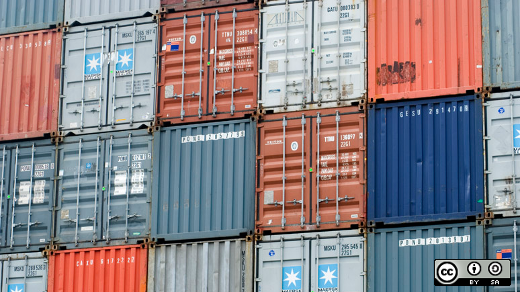
Wikimedia Commons
Linux containers, in short, contain applications in a way that keep them isolated from the host system that they run on. Containers allow a developer to package up an application with all of the parts it needs, such as libraries and other dependencies, and ship it all out as one package. And they are designed to make it easier to provide a consistent experience as developers and system administrators move code from development environments into production in a fast and replicable way.
In a way, containers behave like a virtual machine. To the outside world, they can look like their own complete system. But unlike a virtual machine, rather than creating a whole virtual operating system, containers don't need to replicate an entire operating system, only the individual components they need in order to operate. This gives a significant performance boost and reduces the size of the application. They also operate much faster, as unlike traditional virtualization the process is essentially running natively on its host, just with an additional layer of protection around it.And importantly, many of the technologies powering container technology are open source. This means that they have a wide community of contributors, helping to foster rapid development of a wide ecosystem of related projects fitting the needs of all sorts of different organizations, big and small.
Why is there such interest in containers?
Undoubtedly, one of the biggest reasons for recent interest in container technology has been the Docker open source project, a command line tool that made creating and working with containers easy for developers and sysadmins alike, similar to the way Vagrant made it easier for developers to explore virtual machines easily.
Docker is a command-line tool for programmatically defining the contents of a Linux container in code, which can then be versioned, reproduced, shared, and modified easily just as if it were the source code to a program.
Containers have also sparked an interest in microservice architecture, a design pattern for developing applications in which complex applications are broken down into smaller, composable pieces which work together. Each component is developed separately, and the application is then simply the sum of its constituent components. Each piece, or service, can live inside of a container, and can be scaled independently of the rest of the application as the need arises.
How do I orchestrate containers?
Simply putting your applications into containers probably won't create a phenomenal shift in the way your organization operates unless you also change how you deploy and manage those containers. One popular system for managing and organizing Linux containers is Kubernetes.
[Download our Containers Primer]
Kubernetes is an open source system for managing clusters of containers. To do this, it provides tools for deploying applications, scaling those application as needed, managing changes to existing containerized applications, and helps you optimize the use of the underlying hardware beneath your containers. It is designed to be extensible, as well as fault-tolerant by allowing application components to restart and move across systems as needed.
IT automation tools like Ansible, and platform as a service projects like OpenShift, can add additional capabilities to make the management of containers easier.
How do I keep containers secure?
Container add security by isolating applications from other applications on a host operating system, but simply containerizing an application isn't enough to keep it secure. Dan Walsh, a computer security expert known for his work on SELinux, explains some of the ways that developers are working to make sure Docker and other container tools are making sure containers are secure, as well as some of the security features currently within Docker, and how they function.
Where can I learn more?
Here are some additional resources you may be interested in.
- The Cloud Native Computing Foundation (cncf.io)
- The Open Containers Initiative (opencontainers.org)
- What are containers? (redhat.com)
- Securing containers before they take over the world (thestack.com)
- Containers: 4 key security considerations (containerjournal.com)
- What is Docker? (opensource.com)

